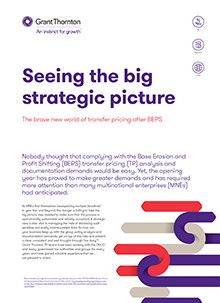-
Risk Advisory
[description]
-
Blockchain & Crypto LAB
After the boom of the last few years, the digital asset ecosystem has managed to position itself as one of the sectors of reference and with an exponential growth forecast. At Grant Thornton, we help our clients to explore all aspects of this technology, to create tailored solutions that bring value to the business and address problems and inefficiencies in the business sector.
The brave new world of transfer pricing after BEPS
Nobody thought that complying with the Base Erosion and Profit Shifting (BEPS) transfer pricing analysis and documentation demands would be easy. Yet, the opening year has proved to make greater demands and has required more attention than many multinational enterprises (MNEs) had anticipated.
So how can you keep up with the group policy analysis and documentation demands, get on top of the risks and present a clear, consistent and well thought-through ‘tax story’?
BEPS Action 13
By opening up transfer pricing to the closest possible scrutiny and potential challenge, BEPS Action 13 (Transfer Pricing Documentation and Country-by-Country Reporting) was never going to be a narrow or straightforward compliance exercise.
The documentation demands open up sizeable operational challenges – meeting reporting deadlines and recording accurate and consistent information. They also raise far reaching strategic questions – does TP reflect the substance of where and how value is created and exchanged within your business? How can you justify your TP approach? What policies and transactions could tax authorities focus on as a basis for TP audit and additional tax demands?
Focusing on the strategic issues
Now the rules have been finalised, there may be a clearer roadmap for what’s required. However, the diverse implementation timelines worldwide are forcing MNEs to juggle multiple deadlines. Many groups were mainly concentrating on the deadlines in year one, with the result that the master file was insufficiently focused. How can your business make the process more manageable and the outputs more accessible, clear and comprehensive?
Taking control of the risks
Documentation alone doesn’t guarantee compliance. Key business considerations include whether the functions, assets and risks are in line with your economic results. Tax authorities are likely to look closely at potential mismatches between documentation, tax returns and financial statements. It’s also important to assess whether the data on functions, assets and risks is up to date. This can be challenging in businesses where there is significant innovation, expansion and/or M&A.
Prevention is better than cure
Transfer pricing documentation is one of those areas where a business might think ‘I’ve filled in the templates, everything is in on time and therefore everything is fine’. In reality, documentation under BEPS goes much further and opens up a host of potential pitfalls. Key documentation may be missed – the three tiers (Country-by-Country Report (CbCR), Master files and Local files) and multiple deadlines heighten such risks.
It’s vital to be clear about what’s involved, how you can take better control and how you can set the narrative. Time and investment now can save a lot of needless expense and aggravation further down the line.
Our Grant Thornton transfer pricing teams have been working with the OECD and many government tax authorities and groups for many years and are pleased to share their experiences.
If you would like to discuss any of the areas raised, please contact your local Grant Thornton adviser or one of the contacts listed in our full article 'Seeing the big strategic picture.

